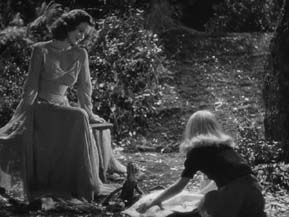Chapter Two - The Rage: Carrie 2 and The Curse of the Cat People
By Brett Beach
October 31, 2009
Without verging off course to consider either of them with a close critical eye, I will offer that in response to the self-directed question three paragraphs above, I would reply: Stanley Kubrick's 1975 "costume drama" Barry Lyndon and Sergio Leone's 1983 gangster/fairy tale Once Upon a Time in America (the full four-hour version, just in case that possibly needs clarification.) These are my favorite films, my desert island films, and films that I believe belong as a part of any discussion centered on "the best of all time, etc." They are both, as are a lot of my other all-time favorites, epic productions, extreme in length and scope and vision. They are still undervalued I think, which perhaps explains part of my affinity towards them. All of Kubrick's films gain with the passage of time and a critical reevaluation and Barry Lyndon may be the last one still not as appreciated as it could and should be. The marriage of costume design, art direction, musical score, cinematography, voiceover (oh god, but I do love voiceover narration, a topic for another time) and yes, despite what you may have heard, great acting from Ryan O'Neal and Marisa Berenson is inscrutable. I hate the cliché "It's a beautiful film to look at," but Barry Lyndon is staggeringly gorgeous and so much more.
America is, along with Miller's Crossing, among the best of the latter-day gangster films this country has produced and I prefer either of them to the now embalmed and enshrined Godfather films. A stately, leisurely paced tale spanning decades (or maybe not), it features an uncharacteristically quiet and haunted performance from Robert DeNiro and an achingly melancholic score by Ennio Morricone. I must confess to being quite shocked when only three years ago I saw Once Upon A Time in the West for the first time and discovered that the very last shot of OUATIA mirrors a key shot in OUATITW. Around such humbling realizations and discoveries is the life of a critic built. And with that, back to our regularly scheduled programming.
To some, it may be desecration that a sequel to Carrie even exists. I try to keep the concept of desecration in relative terms especially when writing about sequels, many upon many of which have no good reason to exist. Making truckloads of money does not qualify as a good reason. The Rage: Carrie 2, released in the spring of 1999, 23 years after the original, can be considered strictly in terms of a studio's (MGM) attempt at bottom-feeding and sucking a few more dollars out of a property by seeing if a franchise can be borne. It opened March 12th and led the pack among the five new wide releases that weekend but still only wound up with an $18 million final gross against a $21 million budget. The moments of The Rage where it works the hardest to forge ties to its predecessor, via key flashback scenes or plot twists, are the ones that smell the most of commerce. Luckily, director Katt Shea and writer Rafael Moreu have more up their sleeve and a surprisingly good little exploitation flick rises up to the occasion in its final moments and transforms into a moving romantic tragedy, albeit one marked with decapitation, evisceration and castration.
Continued:
1
2
3
4
|
|
|
|




